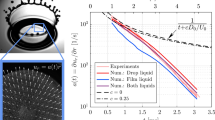Abstract
A computational model was developed to investigate the contribution of classical mass transport and flow parameters to factor X (FX) activation by the tissue factor–factor VIIa complex (TF:VIIa) on one wall of a parallel-plate flow chamber. The computational results were compared to previously obtained experimental data for the generation of factor Xa (FXa) by TF:VIIa on the surface of cultured rat vascular smooth muscle cells. In this study, the complete steady-state convection–diffusion equation was solved using the commercial software package, FLUENT (Fluent Inc., Lebanon, New Hampshire). A user-defined subroutine interfaced with FLUENT implemented the surface reaction which was modeled using classical Michaelis–Menten reaction kinetics. The numerical solutions were obtained for 12 cases which used combinations of three wall shear rates and four reaction rates. The numerically obtained fluxes for a given reaction rate displayed a wall shear rate dependence which ranged from classical kinetic reaction control (no dependence) to pure diffusional control (maximum dependence). The experimental data, however, were not represented by numerical data generated using a single reaction rate. The three numerically obtained fluxes which corresponded most closely to the experimental fluxes were determined using three different V max values. This finding supports the hypothesis that there may be a direct effect of flow on the TF:VIIa complex or the cell membrane. © 1998 Biomedical Engineering Society.
PAC98: 8722-q, 8710+e
Similar content being viewed by others
REFERENCES
Bird, R. B., W. E. Stewart, and E. N. Lightfoot. Transport Phenomena. New York: Wiley, 1960, pp. 513 and 514.
Bloem, L. J., L. Chen, W. H. Konigsberg, and R. Bach. Serum stimulation of quiescent human fibroblasts induces the synthesis of tissue factor mRNA followed by the appearance of tissue factor antigen and procoagulant activity. J. Cell Physiol.139:418-423, 1989.
Darnell, J., H. Lodish, and D. Baltimore. Molecular Cell Biology. New York: Scientific American, 1990, pp. 61 and 62.
Fluent Manual Series. User's Guide, Vols. 1-4, Fluent Inc., Lebanon, New Hampshire, 1995.
Gemmel, C. H., Y. Nemerson, and V. T. Turitto. The effects of shear rate on the enzymatic activity of the tissue factor- factor VIIa complex. Microvasc. Res.40:327-340, 1990.
Gemmel, C. H., V. T. Turitto, and Y. Nemerson. Flow as a regulator of the activation of factor Xby tissue factor. Blood72:1404-1406, 1988.
Gir, S., S. M. Slack, and V. T. Turitto. A numerical analysis of factor X activation in the presence of tissue factor-factor VIIa complex in a flow reactor. Ann. Biomed. Eng.24:394- 399, 1996.
Goldsmith, H. L., and V. T. Turitto. Rheological aspects of thrombosis and haemostasis: Basic principles and applications. Thromb. Haemost. 55:415-435, 1986.
Grabowski, E. F., D. B. Zuckerman, and Y. Nemerson. The functional expression of tissue factor by fibroblasts and endothelial cells under flow conditions. Blood81:3265-3270, 1993.
Hall, C. L. The Effects of Flow on Tissue Factor Activity in Rat Vascular Smooth Muscle Cells. Ph.D. dissertation, The University of Memphis, 1995.
Ichinose, A., and W. Davie. The blood coagulation factors: Their cDNAs, genes and expression. In: Hemostasis and Thrombosis: Basic Principles and Clinical Practice, edited by R. W. Colman, J. Hirsh, V. J. Marder, and E. W. Salzman. Philadelphia: Lippincott, 1994, pp. 19-54.
Leveque, M. A. Les trois de la transmission de chaleur par convection. Ann. Mines13:211-239, 1928.
Levich, V. G. Physicochemical Hydrodynamics. Englewood Cliffs, NJ: Prentice-Hall, 1962, pp. 39-138.
Maynard, J. R., B. E. Dreyer, M. B. Stemerman, and F. Pitlick. Tissue-factor coagulant activity of cultured human endothelial and smooth muscle cells and fibroblasts. Blood50:387-396, 1977.
Miletich, J. P., G. Broze, Jr., and P. W. Majerus. Purification of human coagulation factors II, IX, and X using sulfated dextran beads. Methods Enzymol.80:221-228, 1981.
Nemerson, Y. Tissue factor and hemostasis. Blood71:1-8, 1988.
Nemerson, Y. Tissue factor pathway of coagulation. In: Hemostasis and Thrombosis: Basic Principles and Clinical Practice, edited by R. W. Colman, J. Hirsh, V. J. Marder, and E. W. Salzman. Philadelphia PA: Lippincott, 1994, pp. 81-93.
Nemerson, Y., and R. Gentry. An ordered addition, essential activation model of the tissue factor pathway of coagulation: Evidence for a conformational cage. Biochemistry25:4020- 4033, 1986.
Patankar, S. V. Numerical Heat Transfer and Fluid Flow. New York: Hemisphere, 1980, pp. 160-162.
Slack, S. M., Y. Cui, and V. T. Turitto. The effects of flow on blood coagulation and thrombosis. Thromb. Haemost.70:129-134, 1993.
Slack, S. M., and V. T. Turitto. Fluid dynamic and hemorheologic considerations. Cardiovasc. Pathol.2:11S- 21S, 1993.
Stenflo, J., and B. Dahlback. Vitamin K-dependent proteins. In: The Molecular Basis of Blood Diseases, edited by G. Stamatoyannopoulos, A. W. Nienhuis, P. W. Majerus, and H. Varmus. Philadelphia: Saunders, 1994, pp. 565-598.
Taubman, M. B., J. Marmur, C.-L. Rosenfield, A. Guha, S. Nichtburger, and Y. Nemerson. Agonist-mediated tissue factor expression in cultured vascular smooth muscle cells: Role of Ca2+ mobilization and protein kinase C activation. J. Clin. Invest.91:547-552, 1993.
Versteeg, H. K., and W. Malalasekera. An Introduction to Computational Fluid Dynamics: The Finite Volume Method. Harlow, Essex, England: Longman Scientific and Technical, 1995.
Author information
Authors and Affiliations
Rights and permissions
About this article
Cite this article
Hall, C.L., Slack, S.M. & Turitto, V.T. A Computational Analysis of FXa Generation by TF:FVIIa on the Surface of Rat Vascular Smooth Muscle Cells. Annals of Biomedical Engineering 26, 28–36 (1998). https://doi.org/10.1114/1.120
Issue Date:
DOI: https://doi.org/10.1114/1.120




